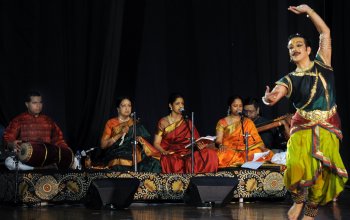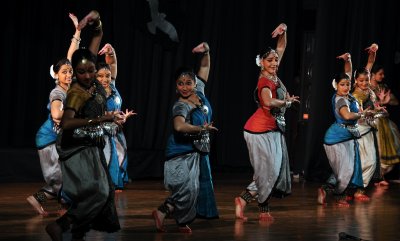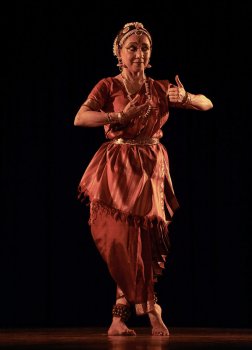
|   |

|   |
Music Academy Dance Festival: Day 6 - Veejay Sai e-mail: vs.veejaysai@gmail.com January 27, 2014 Filmy frowns and feet of clay A day ago, we saw the excellent solo by Sathyanarayana Raju and the second male soloist for the Academy’s dance festival was a face more familiar on the screen than on the stage. That is probably the reason the morning in the Academy had a partially filled middle-row for most people had come to witness the performance of Vineeth the film actor more than Vineeth the dancer.  Vineeth Photo: Thanthoni Vineeth has been a student of veteran guru Padma Subrahmanyam in Bharatanrithyam and his guru was right there on the stage giving him support on the nattuvangam. He began his performance with a Nandeesa Kauthuvam, a composition of Swami Haridas Giri set to Ghambira Nattai ragam and khanda chapu talam. Dressed more like a fading drama actor from an old costume drama, Vineeth performed this piece with much energy. The first thing that struck a highly pleasant chord was the soulful veena played by Kannan Balakrishnan and the melodious voice of his wife Gayathri. One could have closed their eyes for the rest of the show to enjoy their music and it wouldn’t have been any loss of time. Vineeth’s next piece was something that Padma Subrahmanyam performed ages ago; a wonderful tribute to the poet Subramanya Bharathi titled “Valai Kumariyadi” set in the style of a varnam. The poet constantly refers to his muse Kannamma, a recurring character to whom he has written immortal lines. Once again, to lovers of Bharathi’s poems and works, this isn’t unknown. Kannan’s veena and Gayathri’s voice added magic with ragam Kaapi and rang through the hall. However, the same didn’t reflect in Vineeth’s highly filmy dance with liberal doses of his guru’s Bharatanrithyam added in. A highly pronounced disconnect came through between the music on the stage and his dance. In sancharis where he was to depict subtler aspects of romance and love, he ended up being over-dramatic and vociferous. In the next piece he performed, Kulasekhara Azhwar’s lullaby “Mannu Pugazh” from the Divya Prabandham, Vineeth’s portrayal of the act of Mohini in his sancharis was notable. It had finally taken him this long into his performance to warm up enough to get into his element. Even the concluding thillana turned out to be more meritorious for its musical values. Vineeth’s performance portrayed him as a professionally weak dancer in aspects of abhinayam and selected parts of nritta. Signs of a body that has not been habitual into the demanding routine of a dancer were remarkably visible. His filmy reputation overpowers his identity as a classical dancer. Even the great Vyjayanthimala Bali had a successful film career but she never allowed that to touch her career as a Bharatanatyam dancer. She kept the two far apart and proved one could be successful in both, if they were determined enough. One needs to reach that level of smartness and intuition. In the end, Vineeth picked up flowers from the statue of Nataraja on the stage and walked across to the orchestra and placed them in front of his guru. While this unexpected act of displaying his guru bhakthi shocked everyone, we hope Nataraja blesses him with the strength to do good dance. Jayanthi Livingston by the Sea Every other year or season, one always comes across new group productions in the season. Sometimes an idea can inspire a new thought process even though it might not translate into what one can think it could be. Jayanthi Subramaniam’s ‘Jyotir Gamaya’ was her own adaptation of Richard Bach’s classic ‘Jonathan Livingston Seagull.’ The book is well known and so is the story. The inspiring story hasn’t been more relevant in any other time and context as now in our fast-paced world. Bach's bestseller is an uplifting fable of a seagull, Jonathan, who decides he is much more than just a seagull, who wants something else out of life. This story has become a symbol of new age spirituality over the years.  Jyotir Gamaya Photo: Thanthoni Performing to recorded music, Jayanthi’s production had some noteworthy ideas. Using an eclectic mix of Carnatic ragas, Bharatanatyam dance sequences, semi-Odissi costumes and ornamentation, dancers of all sizes and shapes danced as seagulls to engineered choreography. Sumithra Subramaniam as Jonathan, Jayanthi as the older wise gull and others did a good job in their respective roles. While one is used to Nandini Anand’s voice for dance, it was an excellent surprise to listen to Rajkumar Bharathi singing after a long time. Rajkumar has been successfully providing music orchestration to many dance performance over the years. Even in the current production, his idea of using various ragams to create various moods was a smart way of working with the story… Kalyani as Jonathan’s wings warm up to rise, Mayamalavagowla when the other gulls attack Jonathan, Kirawani for a lonely and outcast Jonathan, and so forth. Deeptha Jayakar’s effort at creating a very direct backdrop design was commendable. While most of the narration was good and smooth flowing, the production at large seemed to lack the finesse that was needed. With seagulls breaking into random jathis and adavus, the Bharatanatyam element strongly overpowered the entire subtext of the philosophy. One can use the idiom of Bharatanatyam and still work with choreography that is not so direct. Unnecessary dance sequences to fill gaps made the production only a little longer. If it can be edited to a presentation which is crisper, it has the characteristics of making it big on the national dance map. While the attempt at the production was worthy, it would take a little more work and ideation for it to evolve into something bigger and better. For now, kudos to Jayanthi and her team for pulling off this show. The power of subtlety Year after year we have all seen Leela Samson perform. This year she out-did herself. Like a prima donna who always surprises you with that unexpected show, Leela came, she danced, and she stormed the place and stole the festival!  Leela Samson Photo: Siddharth Chandrasekar The first thing one noticed about the performance was the placement of the orchestra that was facing the audience; a welcome move as the stage at the Academy is large enough to accommodate this design unlike most other venues. Leela opened her performance with an Ardhanarishwara Stotram set to a Ragamalika. Exploring the divine union that transcends notions of genders and sexes, Leela’s depiction was at its contemplative best. This isn’t an uncommon theme or piece to perform in Bharatanatyam. But what made it special was Leela’s treatment to the whole composition. She continued her performance into the famous Navaragamalika varnam “Saamiyai azhaithodi vaa” by Dandayudhapani Pillai. The tale of the heroine requesting her Sakhi to fetch her lover to her felt like it was custom-composed for Leela to perform this piece. If on one side the musical structure of the varnam was enjoyable through the ragas Todi, Mohanam, Vasantha, Devamanohari, Shankarabharanam, Saranga, Kanada, Aarabhi and Bhairavi, which the composer knit into, the other experience of sheer pleasure was to see Leela perform abhinaya to the whole narrative. Neither direct and obvious nor shrouded into any vague choreography, Leela’s performance was overflowing with the power of subtlety. The movement, the metaphor and the word united with the dance, in terms best described by the legendary A K Ramanujan, “like red earth and pouring rain.” Half an hour flew by without realizing! The recital got from better to best when Leela next performed an ashtapadi. Set to raag Hemant by Pt Jasraj long ago, this was performed by Madhavi Mudgal in Odissi style. In “Maadhave maakuru maanini maanamayi,” we got a glimpse of Leela in the story of Sakhi persuading Radha to shed her pride and go meet Krishna. Once again Leela was stellar in her abhinayam. While Kandadevi Vijayaraghavan’s violin and Muthukumar Balakrishnan’s flute added the musical seasoning to the singing, the percussion could have been slowed down further to enhance the mood of the composition. Portraying a completely different nayika in the javali “Maayaladi” set to ragam Todi, one saw the beauty of an unbridled Leela at her best. The nayika telling her friend about the trickster-woman who separated her from her lover was rendered with much sophistication. This performance was turning out to be a buffet for the senses. And like all this wasn’t enough, Leela concluded it with Adi Shankara’s ‘Kaalabhairava Ashtakam.’ Set to ragam Hamsadhwani and choreographed by Sheejith Krishna, this piece displayed the fluidity in Leela’s dance. What made this recital so different from all her older ones and far outstanding from everything else in the Academy’s festival? In this performance, one saw Leela was an expert at her art. Without being too invasive or evident, without being arduous or stressed out, Leela shared something that she nurtured very close to her heart: her art. And give she did willingly with a sense of seeing it grow, metamorphose into an experience worth remembering. Colorfully chaotic and over-stretched In a significantly strong contrast from Leela’s performance was the next show by the dancer couple Nirupama - Rajendra and their group from Bangalore.  Abhinava Dance Company Photo: Siddharth Chandrasekar The show opened with the voice of Faiyaz Khan singing a tune in praise of lord Vishnu, accompanied by Praveen Rao on the tabla. Faiyaz is easily one of South India’s best Hindustani voices and sarangi players. To the corner of the stage they sat on a double-decker platform with two rows of musicians. After this the first item they presented was a teen taal composition. With barely audible bols to even those of us sitting right up in the front, one could let that pass off for being a warm-up exercise before their main piece was to come. Following that was ‘Meera Madhuri,’ a Meera Bhajan set to well-knit choreography around the theme of Meera imagining her love for Krishna. Both Nirupama and Rajendra were excellent in their abhinaya in this piece. The third item ‘Raas Lila’ was what stood out as the best of the whole evening’s presentation. First thing one noticed was the loud and colourful costumes, all in one frame on the stage. Bringing in the celebrations of the immortal Raas of Krishna and his many gopikas, dancers performed with good synchrony as the musicians gave their best music. Noteworthy was the percussion jugalbandi between Praveen Rao on the tabla and Gurumurthy Vaidya on the pakhawaj. Even better was the versatile Varijashree Venugopal who exhibited her dexterity, both in singing and playing the flute. Her voice is as sweet as the flute she plays and she is a talent worth watching out for in the coming years. This was the best of their performance before it went downhill. Performing the next piece ‘Varsha’ to recorded music completely changed the mood of the hall. One wondered why they even chose to perform this when they had some of the finest musicians traveling all the way to give them excellent music. ‘Varsha’ had more smoke on the stage than any mood of rain or the romance associated with it. Bad got worse when they decided to perform ‘Abhimanyu,’ an item that had less dance and more theatrics in it. While Somashekar was excellent in his portrayal of the character, the whole piece as such didn’t fit into the larger scheme of things. They had passed their time of performance and continued. When the Music Academy doesn’t allow this for music concerts during the season, why must dancers be exempt from the same rule? Tedious long announcements in between items stretched their performance time further. While Nirupama could have stuck to brief announcements of what they were presenting next, she would launch into a mini-speech with the mic in her hands. Either way, they weren’t sticking to what was listed in the Academy festival brochure. They finally completed their show with a last item titled ‘Kadam Kadam’ and it was way past 10pm. The audience went home exasperated that the show was finally ‘Khatam Khatam’ and done with. What could have been an otherwise wonderful program ended up being a chaotic act of over-indulgence with no regard for time. All in all, the performance felt like a corporate entertainment show and had very less to do with delving into the classicism of a dance form like Kathak. Veejay Sai is a writer, editor and a culture critic. He is the official reviewer for the Madras Music Academy’s annual dance festival. |